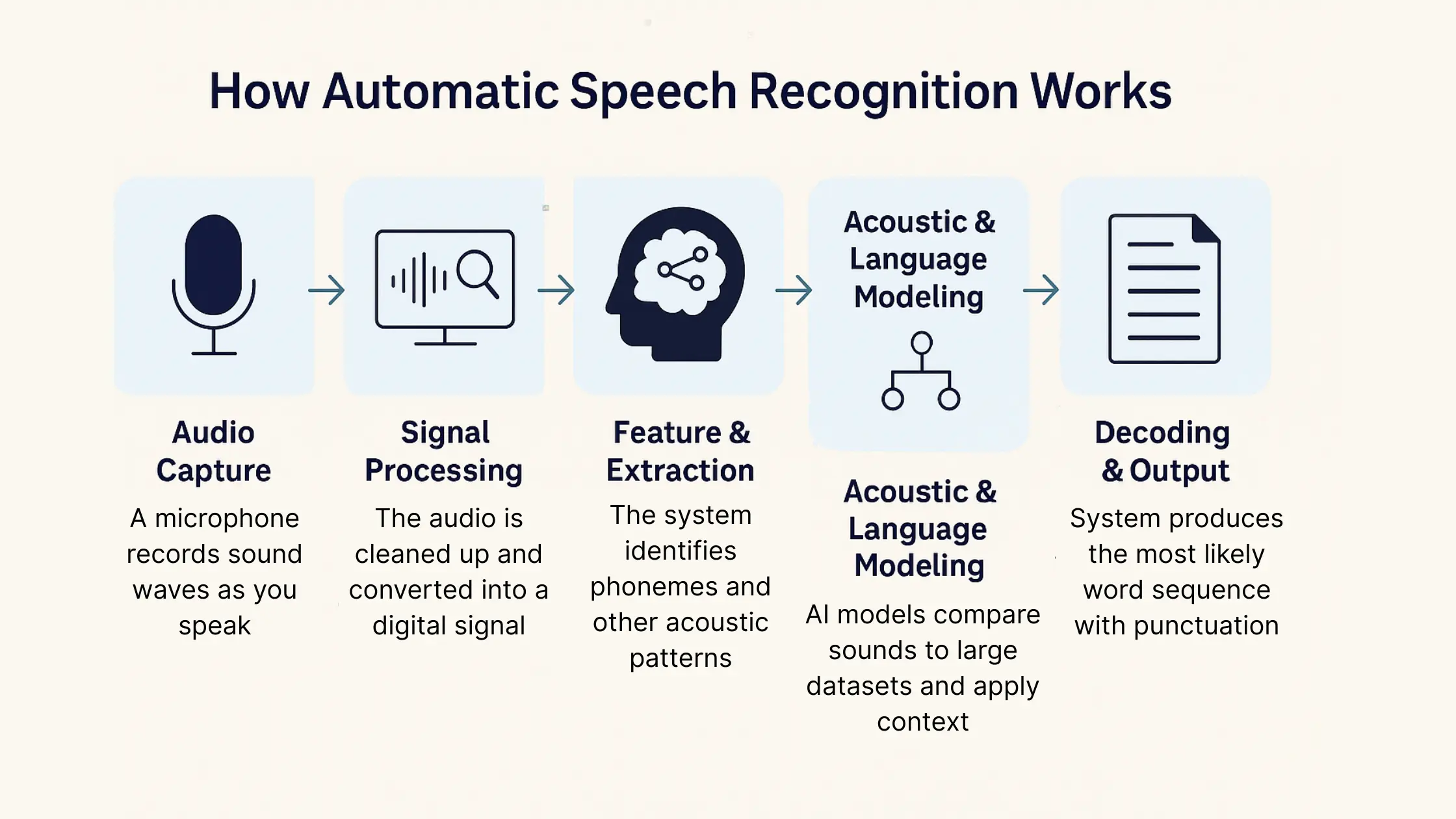Automatic Speech Recognition
(2025-09-23T18:18.730Z)
Perplexity Query
(2025-09-23T18:18
.730Z)
Question:
Write a comprehensive one-page article about "Automatic Speech Recognition".
Model: sonar-pro
Automatic Speech Recognition (ASR) is a technology that converts spoken language into written text, allowing people to interact with computers, smartphones, and other digital devices using their voices.
[u4e9nn]
[q4s0j7]
ASR is significant because it bridges natural human communication and digital systems, making technology more accessible, efficient, and responsive in everyday life.
[ff59h3]
As voice interfaces become an integral part of numerous applications, ASR's impact on productivity, accessibility, and user experience continues to grow.

Understanding Automatic Speech Recognition
At its core, ASR uses artificial intelligence (AI), machine learning (ML), and natural language processing (NLP) to automatically process, analyze, and convert audio speech into text.
[u4e9nn]
[q4s0j7]
When someone speaks into an ASR-enabled device, the system first captures the audio signal, cleans it of background noise, and then analyzes the phonetic and linguistic features using pre-trained models.
[u4e9nn]
[kivu3o]
The recognized speech is output as readable text, which can then be used for a variety of applications.
Practical examples of ASR include:
- Virtual assistants like Siri, Alexa, and Google Assistant, which recognize and process spoken commands to perform tasks.
- Customer service bots and call centers that use ASR to transcribe and interpret customer inquiries for faster, more accurate responses. [ff59h3]
- Live closed captioning for the hearing impaired, enhancing accessibility at events or on video calls.
- Voice dictation tools for hands-free note-taking and document creation in professional and medical settings.
The benefits of ASR are far-reaching:
- Enhanced accessibility for individuals with disabilities, enabling them to interact with technology more freely.
- Increased productivity through hands-free operation, voice transcription, and automated documentation in various industries.
- Efficiency in customer service by enabling faster query resolution and real-time monitoring in call centers.
- Support for multilingual environments with the ability to transcribe and translate spoken words in multiple languages. [kivu3o]
However, ASR still faces notable challenges. Accurately recognizing diverse accents, dialects, and speech patterns remains difficult. Background noise, overlapping conversations, and technical jargon can further impact transcription quality. Privacy considerations are also critical, especially when sensitive information is captured and processed by third parties.
[ff59h3]

Current State and Trends
ASR has seen widespread adoption in both consumer and enterprise sectors. Global market research estimated the value of the voice and speech recognition industry at $14.42 billion in 2021, with projected growth at a compound annual rate of 15.3% through 2030—a reflection of increasing demand for sophisticated voice-enabled devices and applications.
[bs6rdu]
Key players in the ASR space include tech giants such as Google, Microsoft, Amazon, Apple, and a growing cohort of specialized AI startups.
[bs6rdu]
[q4s0j7]
Recent technological advances, particularly in deep learning and end-to-end modeling, have markedly improved ASR accuracy and expanded its capabilities to handle noisy environments, multiple languages, and real-time transcription. New integrations are also emerging in healthcare (for clinical dictation), automotive (voice-controlled navigation), and smart home systems.
[kivu3o]
[q4s0j7]

Future Outlook
Looking ahead, ASR is expected to become more seamless, context-aware, and personalized, integrating tightly with multimodal interfaces and underpinning conversational AI systems. Improvements in understanding context, emotion, and intent will expand ASR's applications, while stricter privacy controls and ethical frameworks are likely to accompany its wider adoption. The transformative potential of ASR suggests it will continue to redefine how humans interact with technology across countless domains.
In summary, Automatic Speech Recognition transforms speech into actionable data, powering everything from daily conveniences to advanced business solutions. As ASR evolves, it promises to make technology even more intuitive, inclusive, and attuned to the nuances of human language.
Citations
[u4e9nn] 2025, Sep 18. What is automatic speech recognition (ASR)? - IONOS. Published: 2025-03-31 | Updated: 2025-09-18
[bs6rdu] 2025, Sep 23. What Is Automatic Speech Recognition (ASR)? - Level AI. Published: 2023-02-12 | Updated: 2025-09-23
[ff59h3] 2025, Sep 22. Automatic Speech Recognition Meaning, Benefits & Challenges. Published: 2025-09-15 | Updated: 2025-09-22
[kivu3o] 2025, Sep 23. What is ASR & how do speech recognition models work? - Gladia. Published: 2024-03-21 | Updated: 2025-09-23
[q4s0j7] 2025, Sep 23. What is Automatic Speech Recognition (ASR)? - Uniphore. Published: 2025-07-21 | Updated: 2025-09-23
[6]: 2025, Sep 23. What is Automatic Speech Recognition? A Comprehensive .... Published: 2025-05-20 | Updated: 2025-09-23
[7]: 2025, Sep 23. What is Automatic Speech Recognition? | NVIDIA Technical Blog. Published: 2022-08-08 | Updated: 2025-09-23
[9]: 2025, Apr 02. Automatic Speech Recognition (ASR): Expert Guide - Verbit. Published: 2023-10-27 | Updated: 2025-04-02